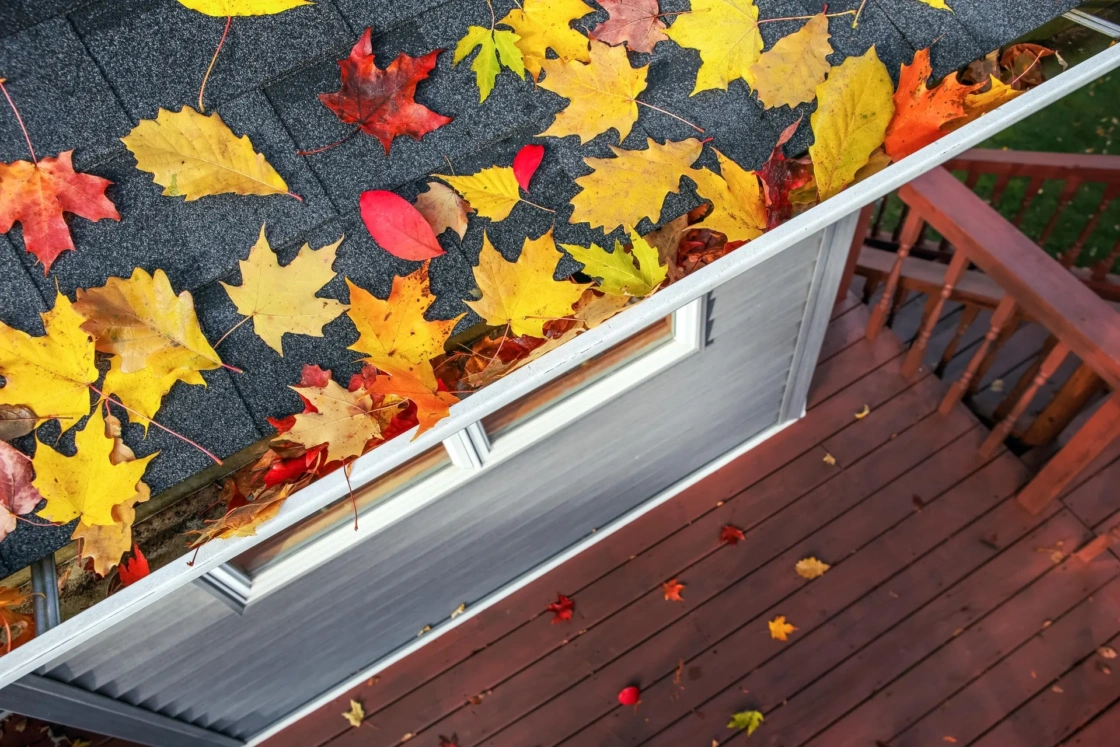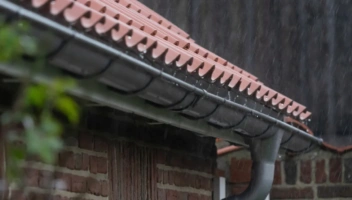When Do Leaves Start to Fall? A Seasonal Guide for Homeowners

The first crisp mornings of fall bring more than cooler air. They bring change to your trees, leaves start to turn, and soon after, they begin to drop. This seasonal shift is beautiful to watch, but it also means work for homeowners. Knowing when leaves fall and how long they keep dropping helps you stay ahead of cleanup and protects your home from clogged gutters and water damage.
Here’s how the process works, when to expect peak fall foliage in different regions, and how to plan your yard care around it.
Why Do Leaves Fall?
Leaves fall because deciduous trees prepare for winter through a process called photoperiodism — they sense shorter days and respond by shutting down chlorophyll production, pulling nutrients back into the tree, and forming an abscission layer that eventually causes the leaf to drop. Through spring and summer, chlorophyll drives photosynthesis and gives leaves their green color.
Typically in mid-September, as daylight hours shrink and nights cool, chlorophyll breaks down. The green fades, revealing carotenoids (yellow and orange pigments) that were always present, while anthocyanins (red and purple pigments) are produced in some species when sugars are trapped in the leaves. Sunny days paired with cool nights intensify these autumn colors.
During this time, trees also form an abscission layer at the base of each leaf stem, cutting off the flow of water and nutrients. When it finishes forming, the leaf detaches. A shift in wind, rain, or even its own weight is often all it takes for the leaf to fall.
Different tree species respond at different rates. Maples may drop soon after reaching peak fall color. Oaks and hickories often hold dry leaves long after other trees are bare. That’s why leaves don’t all fall at once, even in the same yard.
When is Peak Fall Foliage?
Peak fall foliage is the short window when trees show their brightest colors. For many regions, this happens between late September and mid-October, although southern areas reach their best time later. Weather conditions play a big role. Sunny days and cool nights keep colors strong, while storms can strip leaves early.
Peak color usually marks the beginning of heavier leaf drop. For homeowners, it’s the signal to start cleaning out gutters and planning yard care.
Typical Leaf Fall Timeline by Region
Leaf fall varies across the country due to differences in climate, elevation, and local weather. Use this quick guide to know when your leaves are likely to start falling.
| Region | Peak Fall Color | Main Leaf Drop Period |
|---|---|---|
| Northeast | Late September to Mid-October | Mid-October to Early November |
| Midwest | Early to Mid-October | Mid-October to Early November |
| South | Late October to Early November | Early to Late November |
| West | Early October to Late October | Mid-October to Early November |
Northeast Leaf Fall Timeline
New England leads the country in fall foliage. Vermont, New Hampshire, Massachusetts, Maine and Connecticut draw millions of leaf-peeping visitors to scenic byways and state parks every year.
- Peak fall color: Late September to Mid-October
- Leaf drop: Mid-October to Early November
Midwest Leaf Fall Timeline
In the Midwest, colors brighten Michigan, Minnesota, Wisconsin, and Ohio through early and mid-October. Leaves begin to drop quickly once peak fall foliage passes.
- Peak fall color: Early to Mid-October
- Leaf drop: Mid-October to Early November
South Leaf Fall Timeline
In the South, from the Smoky Mountains to northern Florida, fall comes later. Colors linger longer, and leaves often stay until well into November.
- Peak fall color: Late October to Early November
- Leaf drop: Early to Late November
West Leaf Fall Timeline
The West has a mixed schedule. Aspens in Colorado turn golden in early October. Higher elevations of Oregon peak around the same time. Lower elevations, including much of California, often hold leaves until late October.
- Peak fall color: Early to Mid-October in higher elevations; Late October in lower elevations
- Leaf drop: Mid-October to Early November
When Do Leaves Stop Falling?
Most trees finish shedding by mid-November. Weather conditions like early frost or drought conditions affect how long the process lasts. Strong winds or heavy rain can bring leaves down all at once, but calm weather stretches leaf fall across several weeks. Oaks may hold brown leaves into early winter.
Autumn Landscaping Tips: What Falling Leaves Mean for Your Home
Falling leaves may look harmless, but they create work you can’t put off. Leaves on your lawn block sunlight and trap moisture, leaving bare spots behind. On walkways, wet leaves turn slick and unsafe.
When leaves pile in gutters, the risk grows. They soak up water, get heavy, and form clogs. During storms, water can spill over, damaging roofs, siding, and foundations. Next, we’ll walk you through simple steps and preventative measures to keep your yard and home safe as the leaves come down.
Help Prevent Gutter Clogs and Water Damage
Wet leaves in gutters can create dense blockages that stop water from draining. Rainwater then spills over the edges, seeping into walls and weakening structures. Cleaning out your gutters early (ideally in late September or early October, depending on where you live) and keeping them cleared out throughout the season can help prevent serious damage.
Want to avoid the cycle of cleaning? Consider a proven gutter protection system. LeafFilter® keeps leaves and debris out of your gutters while letting water flow through, backed by a clog-free guarantee. If your gutters are already failing, a full gutter replacement can help prevent future damage.
Leaf Cleanup and Yard Prep Tips
Stay ahead of the mess by cleaning in stages. Don’t wait for the last leaf to fall. Use a rake for smaller areas, a leaf blower for large spaces, and a mulching mower to break leaves down into lawn-friendly nutrients, saving you the step of bagging.
Collected leaves make excellent compost for gardens. Bag them only if composting isn’t an option. Plan cleanup around your area’s leaf drop schedule to keep your yard safe and healthy all season.
Planning Your Yard Care Around Leaf Fall
Time your yard work to follow the changing seasons. In northern areas, leaves can start dropping as early as late September, while in southern regions, cleanup may not be necessary until November. Wherever you live, clear leaves often, especially from driveways, decks, and gutters, to keep everything safe and tidy.
The best way to stay ahead is prevention. Installing gutter protection before peak leaf drop—ideally in late summer or very early fall—makes the job easier and helps prevent clogs before they start forming inside your gutters. LeafFilter blocks leaves while letting water drain through, cutting down on fall maintenance for homeowners and helping protect your home from water damage.
By taking preventive steps early, you can enjoy the season without worrying about clogged gutters, slippery walkways, or yard damage.
Request a free quote today and prepare your home for the season ahead.
Frequently Asked Questions
When do most trees in my region start dropping leaves?
It depends on where you live. In the Northeast and Midwest, leaves usually start falling by mid-October. In the South, leaves drop a little later, often in early November. In the West, it varies more: higher elevations lose leaves earlier than low elevation areas.
What causes leaves to fall?
Shorter days and cooler temperatures trigger a process called photoperiodism, which signals the tree to prepare for winter. Chlorophyll breaks down, letting other colors show, and an abscission layer forms at the base of each leaf, gradually cutting it off from the tree and allowing it to fall.
How long do leaves fall for?
Most trees shed their leaves over four to six weeks, though this can vary by species and region. Weather can speed things up or slow them down. Strong winds or storms knock leaves down quickly, while calm, sunny days stretch the season out.
Should I rake leaves or mulch them?
Both have their place. Raking clears the lawn fast, while mulching chops leaves into pieces that feed the soil as they break down. Many homeowners mix the two: raking in heavy areas and mulching where the layer is thin.
Can falling leaves damage my home?
Yes. When leaves collect in gutters, they hold moisture and block water flow. Overflow during storms can harm your roof, siding, and even your foundation. Regular cleanup helps, and gutter protection like LeafFilter® keeps leaves out so water can drain through as it should.


